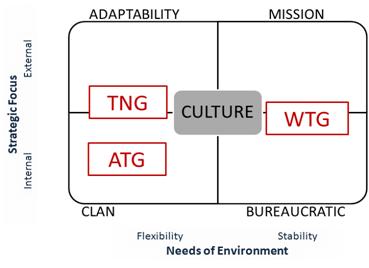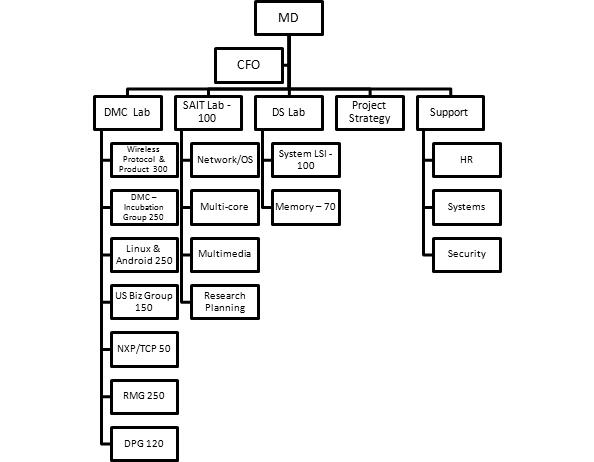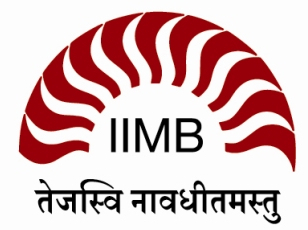This article studies the organisation structure, culture and current challenges being faced by Samsung India Software Operations. The evolution of the organisation is traced as well as the significant influence of Samsung Korea on the culture of the organisation here. A comparison is drawn between Samsung India of today and Samsung Korea of early 90’s and how the organisation is facing environmental threats by re-engineering.
From a grocery shop to the largest global conglomerate, Samsung has grown exponentially over the last 71 years. Samsung has often been referred to as the “Republic of Samsung” as it is one of the major drivers of South Korea’s economy contributing to nearly 20% of South Korea’s exports. True to its Korean name which literally means ‘3 stars’, Samsung Corporation essentially has 3 multinational heavyweights – Samsung Electronics(SEC), Samsung Heavy Industries and Samsung Engineering and Construction (Refer Exhibit 1). Samsung Electronics has played a pivotal role in the growth of this global giant, by occupying the coveted place of the global market leader in over 60 products. In 2007, it earned the distinction of becoming the world’s second largest mobile phone manufacturer.iIt is ranked among the top 20 brands in the world and generated revenues of $110.35 billion USD for the year 2008.ii
 Exhibit 1 Samsung's missioniii
Exhibit 1 Samsung's missioniii
Samsung India Software Operations (SISO) was established with the primary aim of creating better products and services for SEC, has evolved into a 2000+ strong organisation located in Bangalore. Within the last 10 years, SISO has grown from strength to strength having achieved software quality certification (CMM level 5) and ISO 9002. SISO is known to practice Six Sigma management methodology to maximize productivity. It has made significant contributions to Wireless, Networking, Convergence, Digital and Semiconductor technologies.
Evolution of SISO
Samsung India Software Operations (SISO) was setup in 1996 with a vision “To become a World class R&D centre for Samsung Electronics with Software Excellence as its core competency”.iv The mission statement of SISO is “Continuous Innovation” and it reads as “SISO believes in devotion of its human resources and technology to render better services and support Samsung Electronics in creation of superior products and services, adding an ample bit to a better global society”.v
Starting out in 1996 with two divisions, Digital Convergence Division (DCD) and Wireless Technology Division (WTD), aimed at developing new technologies for different divisions of Samsung Electronics in Korea and at productizing the new technologies developed for mobile telephony respectively, SISO has evolved into a behemoth completely unrecognizable to its original form. The number of employees at SISO has grown extensively from 700 a few years back to a current strength of 2600+. The organisation that started with two divisions in 1996 had seven different technology divisions by mid-2009. Among these the Wireless group is much larger than even all the other groups put together. The groups at SISO along with their competencies is provided in Exhibit 2

Exhibit 2 Groups at SISO along with their individual strengths in Mid-2009
Work Culture at Samsung
The culture at Samsung promotes a high degree of work ethic and culture. Samsung Korea lays a tremendous emphasis on working like a closed family environment. All manager and seniors are given due respect as they in a family culture. They are seen as source of inspiration and knowledge. When teams go out to for team lunches or dinner it is imperative that the manager pays the bill, as he is the senior most person in the group. He naturally commands the respect and the rest of the people would acknowledge the fact and exercise restraint.<>
The Korean culture is very rewarding and motivates people to excel in their activities. They have been laying huge emphasis on developing soft skills of their employees and being creative. They are discouraging working overtime, which was very common in previous decade and before. They dole out huge bonuses to high performers and encourage the spirit of leadership among each and every employee by inculcating a sense of importance and responsibility. Finally, the people retire at a young age around 40 and they work as contract based managers for the firm.
Interestingly, there seems to be huge impact of Korean culture even on Samsung India (Refer Exhibit 3). The Koreans have a sense of culture unique to them in terms of their working pattern, the work ethics and relations. The Korean culture talks about:
- Family culture, discipline – ‘Samsung Family’
- Adherence to Quality – ‘Quality First’
- Motivation – ‘Sense of Crisis
- Simplicity - ’Elegance of solution’
- Foster Innovation - ’Creativity'

Exhibit 3 Cultures across divisions
SISO provides a beautiful example of several work cultures co-existing within the same organisation. On one hand is Wireless Technology Group (WTG), the largest division in terms of number of employees and revenues – with a mix of bureaucratic and mission culture. They are primarily involved in product commercialization. Hence, their focus is on achieving efficient processes and delivering timely products. On the other hand is Advanced Technology Group (ATG), the R&D centre, with Clan culture. The research outlook asks for flexibility and focus on the employees more than processes or results. Telecom Networks Group (TNG) is a special case, with a mix of Adaptability & Clan cultures.
Sources of Power & Conflict
The customer for most of SISO’s projects is some technology group in Samsung Korea. At times, these groups or teams in Korea might be competing with each other to come up with similar technologies. This strategy is used at Samsung Korea to promote internal competition and innovation. However, when the work is delegated to India, two Indian teams might be working on similar projects, but for different competing Korean teams. This leads to a situation where two teams might have conflicting goals but are unaware of the situation. This has led to a very stringent Security Policy at SISO.
Secondly, there is interesting horizontal distribution of power between SISO’s groups. ATG, which predominantly follows a clan culture, is non-substitutable because the employees have high technical expertise. On the other hand the WTG, has a major say in the decision making process because it is the revenue generator at SISO. Also, because of its size (1600 employees), it has a significant amount of political power in the organisation and has a say in the resource allocation within the organisation. Moreover, various company policies are decided based on needs of WTG. For example: there is a strong emphasis on strict timings, late attendance, and strict adherence to formal procedures. These are necessary for routine tasks of WTG. However, application of similar policies in other divisions, where more flexibility is needed – creates a problem for the organisation.
Challenges before SISO
SISO is at a stage of its lifecycle where it has grown a lot in size. It has performed well and earned respect of its customer, namely Samsung Korea. However, until now SISO was leveraging on its low cost advantage. However, with time the salaries and living standards in India have also, been rising. Considering the changing internal & external environment, Samsung Korea’s changing strategic focus, the major challenges for SISO are:
- Curbing Imbalanced Growth: one division (WTG) yielding too much power.
- Improving Efficiency: In many projects, due to lack of adherence to formal procedures or lack of training – lot of extra time is spent. The newly appointed Managing Director, Mr. Bang Hun Chun further pointed out, “At SISO engineers are working very hard, pointed as out. But, it is more important to work smart than to work hard’.
- Fostering Innovation: With the dynamic environment prevalent today, it is important for SISO to brand itself as a true R&D lab for Samsung. It cannot afford to rest on its past laurels. This is all the more critical, considering the stiff competition posed by China R&D Lab.
Recent Developments & Future Strategy
Interestingly, the challenges identified by us seem to have been addressed by two very recent changes in SISO: the appointment of a new Managing Director and drastic changes in organisation structure.
The major SISO challenges were clearly delineated by the new appointee. Firstly, SISO was losing low cost advantage – labour and currency. Secondly, too much bureaucracy had crept in – managers were treating subordinates as machines. Finally, there was lack of innovation and efficiency – employees were working hard, but not smart. For these issues he suggested a four point vision:
- Evolve SISO into a global player
- Focus on advanced R&D
- Strengthen software development capabilities
- Develop SISO as global training centre
This was to be achieved by following mission:
- Developing “Software architects” – to improve the R&D division’s brand value
- Inculcate Software engineering principles at ground level
- Conversion of SISO from an R&D centre to a Lab and eventually a Hub
- SISO re-branding into a ‘Highly Recognisable Organisation’
Further, a major reorganisation was also accomplished at SISO. The new SISO structure is provided in Exhibit 4.

Exhibit 4 New SISO Structure
Clearly, this structure was in line with the new vision of encouraging innovation and efficiency – by having laboratories instead of divisions. Interestingly, in the new structure the power of WTG due to its size was also taken away by dividing it into smaller groups.
Is SISO of 2009, the Samsung Electronics of 1993?
Based on our analysis, we found a number of similarities between SISO in 2009 and Samsung Electronics Corporation in 1993. The first of these was the loss of the low cost advantage. In Korea, with the removal of trade import restrictions, SEC lost its competitive edge that it had been enjoying for decades. Similarly, in India, with globalization flattening out the market into a level playing field, India is slowly losing the similar advantage. A second similarity is that the size of the organisation has grown exponentially. This has resulted in unprecedented levels of bureaucracy within the organisation. This can stifle innovation and result in a class of unmotivated managers.
The objectives as enunciated by the new management were to evolve SISO into a global player, shift focus to advanced R&D, strengthen software development capabilities and develop SISO into a global training centre. In order to achieve these goals, firstly a “Software Architect” programme was introduced to train managers extensively for a period of 5 years. The second measure was to implement strict adherence to the Software Engineering Principles to improve quality of SISO’s products. The third measure was the initiation of the process of transformation of SISO from an R&D Centre into an R&D Lab and eventually an R&D hub that would serve as a centre of global excellence. The final step to foster innovation was to re-brand SISO into a “highly recognizable organisation”.
Conclusion
Given the limitations of the original organisation structure, re-engineering seems to be the key to foster greater growth and innovation at Samsung India Software Operations. This is more important in the light of recent developments of losing out on low-cost advantages and lower efficiency. How successful the re-organisation will be, remain yet to be seen.
Keywords
Samsung, Samsung India Software Operations, SISO, restructuring, Organisation Management, Organisational Structure, radical shakeup, re-engineering, work culture, low cost advantage, South Korea, Bangalore, India
Contributors
Amit Gupta is an Associate Professor in the Organisational Behavior and Human Resource Management Area. He holds a PhD. in Organisational Behaviour from Robert H. Smith School of Business at the University of Maryland. He also has a Post Graduate Diploma in Management (Agriculture) from Indian Institute of Management, Ahmedabad and a Bachelor of Science degree from National Dairy Research Institute at Karnal, India. He can be reached at amitg@iimb.ernet.in
Akhil Gupta (PGP 2009-11) holds a Bachelor's Degree in Electrical Engineering from Indian Institute of Technology (IIT) Kanpur. He can be reached at akhil.gupta09@iimb.ernet.in
Maria Cheryl Fernandez (PGP 2009-11) holds a Bachelor's Degree in Electronics and Electrical Engineering from College of Engineering, Guindy, Anna University. She can be reached at maria.fernandez09@iimb.ernet.in
Pulkit Jain (PGP 2009-11) holds a Master’s & Bachelor's Degree in Mechanical Engineering from Indian Institute of Technology (IIT) Bombay. He can be reached at pulkit.jain09@iimb.ernet.in
T Srirathivarman (PGP 2009-11) holds a Bachelor's Degree in Electronics and Electrical Engineering from College of Engineering Guindy, Anna University. He can be reached at srirathivarmant09@iimb.ernet.in
Tejas Dave (PGP 2009-11) holds a Bachelor's Degree in Electronics Engineering from University of Texas, Dallas. He can be reached at tejas.dave09@iimb.ernet.in
References
- Samsung Becomes the World's Second Largest Mobile Phone Vendor, http://www.cellular-news.com/story/25222.php, Last accessed on 7th Jan, 2010
- Quaterly Earnings Report, http://www.samsung.com/sec/aboutsamsung/ir/financialinfo/downloads/2008/20084Q_Earnings_Announcement.pdf, Last accessed on 7th Jan, 2010
- Samsung's Vision and Mission, http://www.samsung.com/in/aboutsamsung/corporateprofile/visionmission.html, Last accessed on 7th Jan, 2010
- Vision Statement, http://www.samsungindiasoft.com/default.asp?page=vision, Last accessed on 7th Jan, 2010
- Company Philosophy and Mission, http://www.samsungindiasoft.com/default.asp?page=mission_and_philosophy, Last accessed on 7th Jan, 2010
- Richard C. Daft, 2008, Organisational Theory, Change, and Design, New Delhi: Thomson Learning, Page 378
- Image: Copyright 2007 Samsung Electronics, India Software Operations Ltd.
